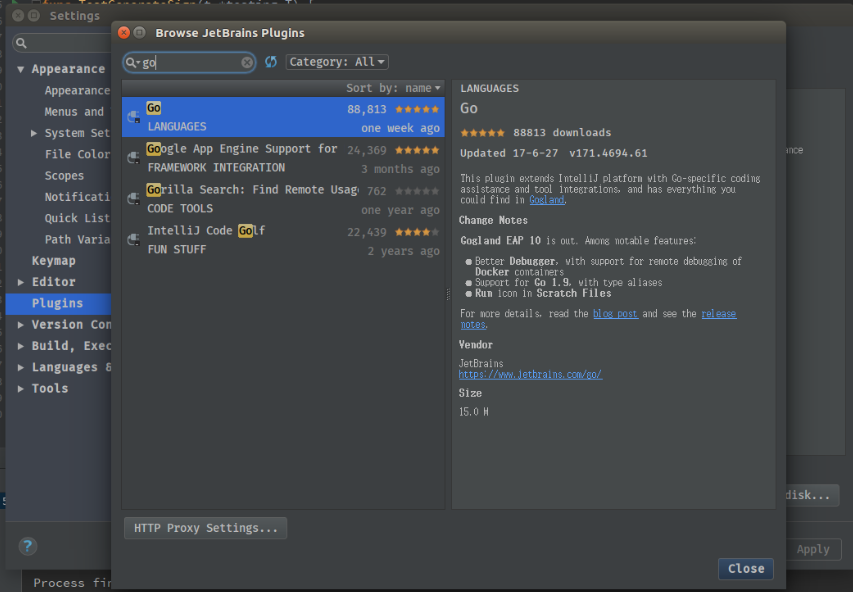本文主要就go语言的学习发展,总结自己在学习的道路上遇到的问题,同时对学习资源进行归纳总结,以方便共同学习
概述
近年来语言的飞速发展,的确给大家带来一种应接不暇的现象,究竟如何取舍,的确是让人挺纠结的。自从Google宣布,kotlin 作为android开发的首选语言,java的地位能否像以前一样不得而知,但是基于jvm的语言(Groovy,Kotlin)的发展也让大家看到每种语言在处理特定问题的优势;gradle基于groovy,开发新一代的构建工具,个人觉得你极大提高了生产力,在持续集成领域,无疑增加了一剂猛药。可以看到groovy在领域特定语言上的优势。
- 客户端 客户端领域需要一种高效,快速实现业务的语言
- 服务端 J2EE开发不断的发展,在起初搭建项目时,过多而又繁琐的配置,让人觉得java越来越臃肿;微服务的出现似乎要打破这种令人窒息的垂直架构,转而向分布式系统进发,spring boot的诞生就可以看出来;此前各种RPC框架的也在服务化打下良好的基础 docker虚拟化技术,似乎需要一种简洁的方式来实现web端的开发,是否有一种语言能够做到轻量级,答案是go语言
一.学习指引
语言的发展总是相互学习,因此对比式的方法能帮助我们快速理解新语言的新特性
1.1 Go 语言安装
Gvm 安装
bash < <(curl -s -S -L https://raw.githubusercontent.com/moovweb/gvm/master/binscripts/gvm-installer)
执行gvm install go1.8.1出现以下错误:
##### Building Go bootstrap tool.
cmd/dist
ERROR: Cannot find /home/liaojinlong/go1.4/bin/go.
Set $GOROOT_BOOTSTRAP to a working Go tree >= Go 1.4.
先安装go1.4
gvm install go1.4 -B
1.2 Go开源项目安装方法
NOTE: 这里解释一下安装过程中出现的问题,方便以后追溯 go安装,推荐gvm方式安装,类似node的npm,ruby的rvm
- go get 无法下载github项目,可以使用如下类似的命令手动下载项目
git clone https://github.com/revel/examples.git $GOPATH/src/github.com/revel/examples
开发工具JetBrain
- 激活activeserver
http://idea.iteblog.com/key.php
- 安装go plugin

二.基本要点
- 官方网站go学习站点 带你一步一步的认识go语言基本特性
- build-web-application-with-golang
- Go 语言学习资料与社区索引
- An Introduction to Programming in Go
2.1 基本数据结构
- array
- slice 两者定义的的区别
- point
- Map map取值的多值返回特性
Test that a key is present with a two-value assignment:
elem, ok = m[key]
package main
import "fmt"
func main() {
m := make(map[string]int)
m["Answer"] = 42
fmt.Println("The value:", m["Answer"])
m["Answer"] = 48
fmt.Println("The value:", m["Answer"])
delete(m, "Answer")
fmt.Println("The value:", m["Answer"])
v, ok := m["Answer"]
fmt.Println("The value:", v, "Present?", ok)
}
- Func 多值返回 函数也是值。他们可以像其他值一样传递,比如,函数值可以作为函数的参数或者返回值
package main
import (
"fmt"
"math"
)
func compute(fn func(float64, float64) float64) float64 {
return fn(3, 4)
}
func add (fn func(int,int) int) int{
return fn(1,2)
}
func main() {
fmt.Println(compute(func(x, y float64) float64 {
return math.Sqrt(x*x + y*y)
}))
fmt.Println(add(func(x,y int) int {
return x+y
}))
}
- 闭包 闭包是由函数及其相关引用环境组合而成的实体(即:闭包=函数+引用环境)
package main
import "fmt"
func adder() func(int) int {
sum := 0
return func(x int) int {
sum += x
return sum
}
}
func main() {
one := adder()
fmt.Println(one(1))
}
- method
Go 没有类。然而,仍然可以在结构体类型上定义方法。方法接收者 出现在 func 关键字和方法名之间的参数中
package main
import (
"fmt"
"math"
)
type Vertex struct {
X, Y float64
}
func (v *Vertex) Abs() float64 {
return math.Sqrt(v.X*v.X + v.Y*v.Y)
}
func main() {
v := &Vertex{3, 4}
fmt.Println(v.Abs())
}
method和func在定义上有类似之处
2.2 面向对象
2.2.1 struct
由于go语言中没有对象的概念,需要借助method和struct实现多态的特性
package main
import (
"fmt"
"math"
)
type Rectangle struct {
width, height float64
}
type Circle struct {
radius float64
}
func (r Rectangle) area() float64 {
return r.width*r.height
}
func (c Circle) area() float64 {
return c.radius * c.radius * math.Pi
}
func main() {
r1 := Rectangle{12, 2}
r2 := Rectangle{9, 4}
c1 := Circle{10}
c2 := Circle{25}
fmt.Println("Area of r1 is: ", r1.area())
fmt.Println("Area of r2 is: ", r2.area())
fmt.Println("Area of c1 is: ", c1.area())
fmt.Println("Area of c2 is: ", c2.area())
}
2.2.2 interface
go语言没有implement关键字,接口的实现利用method实现
type Human struct {
name string
age int
phone string
}
type Student struct {
Human //匿名字段Human
school string
loan float32
}
type Employee struct {
Human //匿名字段Human
company string
money float32
}
//Human对象实现Sayhi方法
func (h *Human) SayHi() {
fmt.Printf("Hi, I am %s you can call me on %s\n", h.name, h.phone)
}
// Human对象实现Sing方法
func (h *Human) Sing(lyrics string) {
fmt.Println("La la, la la la, la la la la la...", lyrics)
}
//Human对象实现Guzzle方法
func (h *Human) Guzzle(beerStein string) {
fmt.Println("Guzzle Guzzle Guzzle...", beerStein)
}
// Employee重载Human的Sayhi方法
func (e *Employee) SayHi() {
fmt.Printf("Hi, I am %s, I work at %s. Call me on %s\n", e.name,
e.company, e.phone) //此句可以分成多行
}
//Student实现BorrowMoney方法
func (s *Student) BorrowMoney(amount float32) {
s.loan += amount // (again and again and...)
}
//Employee实现SpendSalary方法
func (e *Employee) SpendSalary(amount float32) {
e.money -= amount // More vodka please!!! Get me through the day!
}
// 定义interface
type Men interface {
SayHi()
Sing(lyrics string)
Guzzle(beerStein string)
}
type YoungChap interface {
SayHi()
Sing(song string)
BorrowMoney(amount float32)
}
type ElderlyGent interface {
SayHi()
Sing(song string)
SpendSalary(amount float32)
}
NOTE: go语言中没有类的概念,想实现面向对象的设计,需要依赖type自定义类型,然后利用method方法实现
type MyInterface interface{
someMethod()
}
type MyType struct{}
var _ MyInterface = &MyType{}
上面方法会报错,因为其并没有定义someMethod方法,代表其没有实现MyInterface接口
实现MyInterface的 method如下
func (myType *MyType) someMethod()
-
空interface
任意的类型都实现了空interface(我们这样定义:interface{}),也就是包含0个method的interface 一个函数把interface{}作为参数,那么他可以接受任意类型的值作为参数,如果一个函数返回interface{},那么也就可以返回任意类型的值
-
隐式接口
有点类型java interface的继承关系,用于扩展接口方法
-
反射
2.3 并发
三.高级进阶
3.1 网络编程
3.2 开源框架
开源项目是进一步学习一门语言的敲门砖,每当你感觉技术瓶颈的时候,开源项目总能改你带来意外的惊喜,因此学习别人的代码也是在促进自己进步。这里推荐的开源项目包括一种框架提供解决问题的整体方案;一个独立项目能够独立完成一项业务需求即可
3.3 分布式系统设计
参考资料
- Effective Go
- 如何同步 Github fork 出来的分支
- How To Install Ruby on Rails on Ubuntu & LinuxMint using RVM
- GitHub Pages 绑定来自阿里云的域名